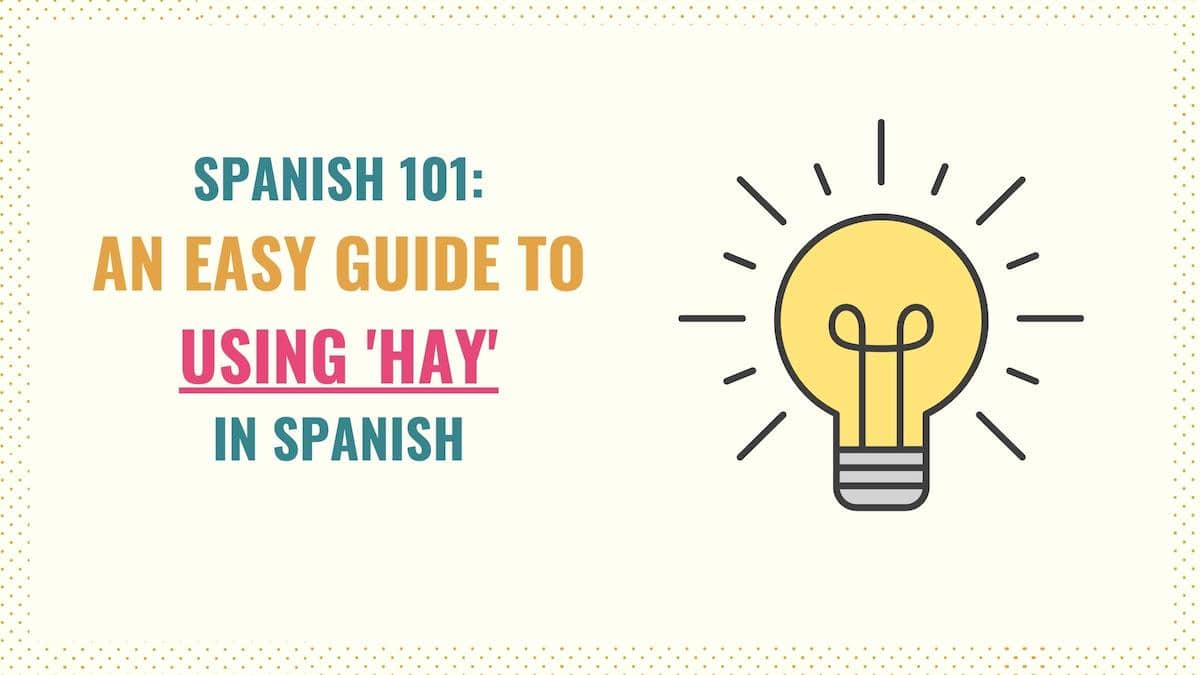Regardless of your command of Spanish, hay is a word you’ll never stop using. Since this is such an essential term, in this guide, you’ll learn everything you need to know about hay in Spanish. Here is a quick overview of what we’ll cover:
- What Does Hay Mean in Spanish
- How & When to Use Hay in Spanish
- Different Forms of Hay (Tenses)
- Bonus: Idioms & Phrases
- Key Points
What Does Hay Mean in Spanish?
The impersonal form hay is used to point out the existence or presence of something in a particular place. Therefore, in this context, it means ‘there is’ or ‘there are’. When using the structure hay que + infinitive, this word expresses obligation and means “let’s do something” or ‘to have to’.
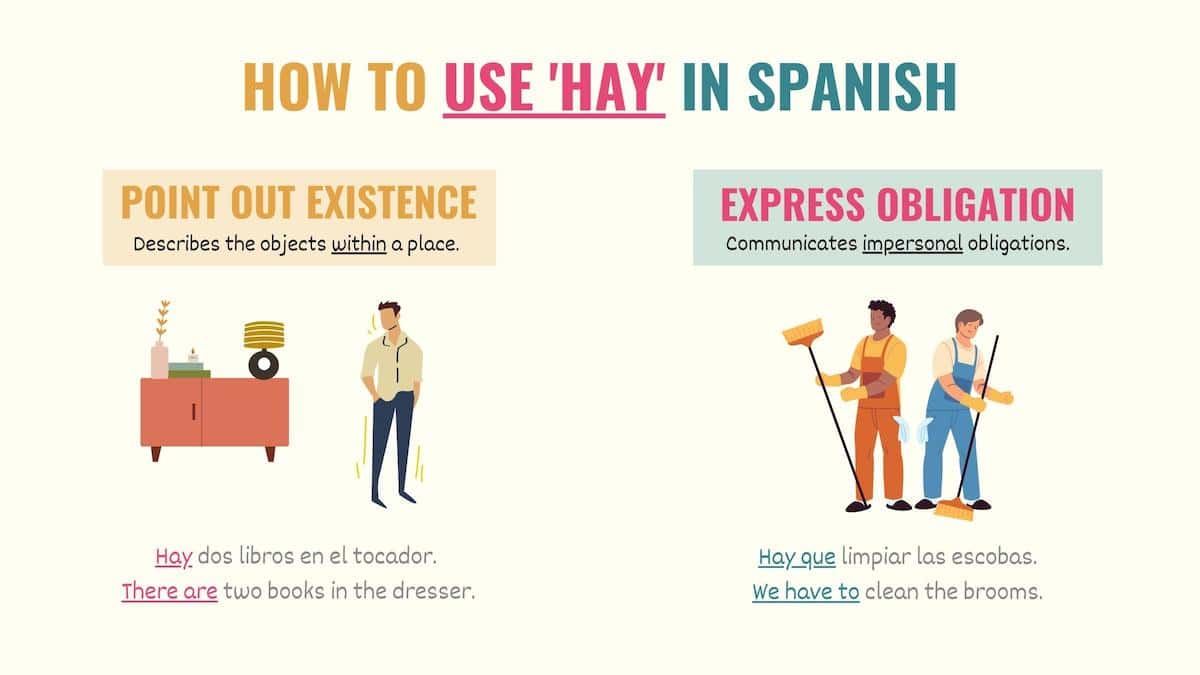
Take Note: In Spanish, the letter ‘h’ is silent. As a result, ‘hay’ sounds very similar to the English word ‘aye’. Here is a recording so you can check its pronunciation.
Hay is the impersonal form of the verb haber. This means that it’s always used in the singular form, regardless of whether the noun which follows it is plural or singular.
Hay una pluma en la mesa.
There is a pen on the table.
No hay muchas sillas disponibles.
There are not many chairs available.
In the sections below, you’ll learn more about the uses of ‘hay’ in Spanish and the elements you must use in each context.
Take Note: Ay and hay are easily confused because their sound and spelling are similar. However, ay is an exclamation that expresses some kind of emotion. Both words are very common, so make sure you understand the difference between ay and hay.
How & When to Use Hay in Spanish
As established above, in Spanish, hay is used to:
- Point out the existence of something
- Talk about obligation
Point out the existence of something – Hay
One of the most common uses of hay in Spanish is to point out the existence or presence of something in a place. So, in this context, ‘hay’ is the equivalent of ‘there is’ or ‘there are’.
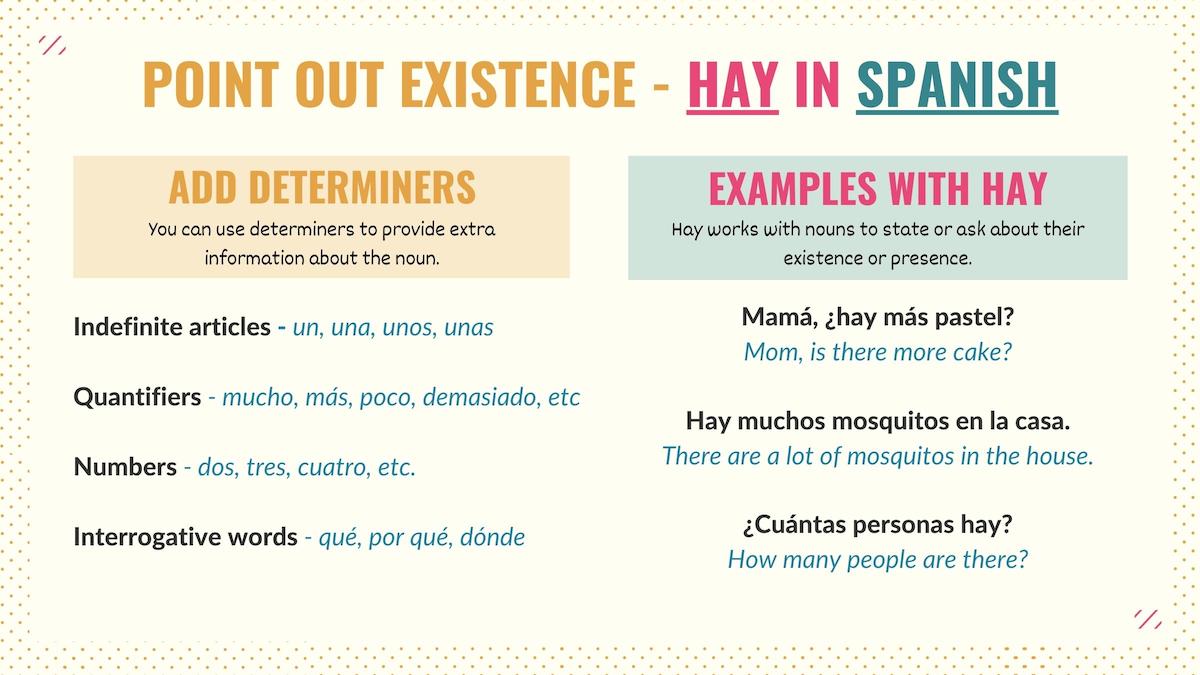
With this meaning, hay is always followed by a noun (it can be countable or uncountable nouns). Additionally, you can use the following types of words (determiners) to provide additional information:
- Indefinite articles (un, una, unos, unas)
- Quantifiers (mucho, más, poco, demasiado, etc)
- Numbers (dos, tres, cuatro, etc)
- Interrogative words (qué, por qué, dónde)
Hay + [determiner] + [noun]
Hay dos gatos en el patio.
There are two cats in the yard.
Mamá, ¿hay más pastel?
Mom, is there more cake?
Hay muchos mosquitos en la casa.
There are a lot of mosquitos in the house.
You can also use the question word cuánto to ask the amount of things that there are in a certain place.
¿[Cuánto] + [noun] + hay?
¿Cuántas personas hay?
How many people are there?
Luis, ¿cuánto dinero hay en la mesa?
Luis, how much money is there on the table?
Take Note: As an impersonal form of ‘haber’, hay doesn’t mark the number or gender of a noun. However, the adjectives you use must convey this information (such as ‘cuánto’).
Talking about obligation – Hay que
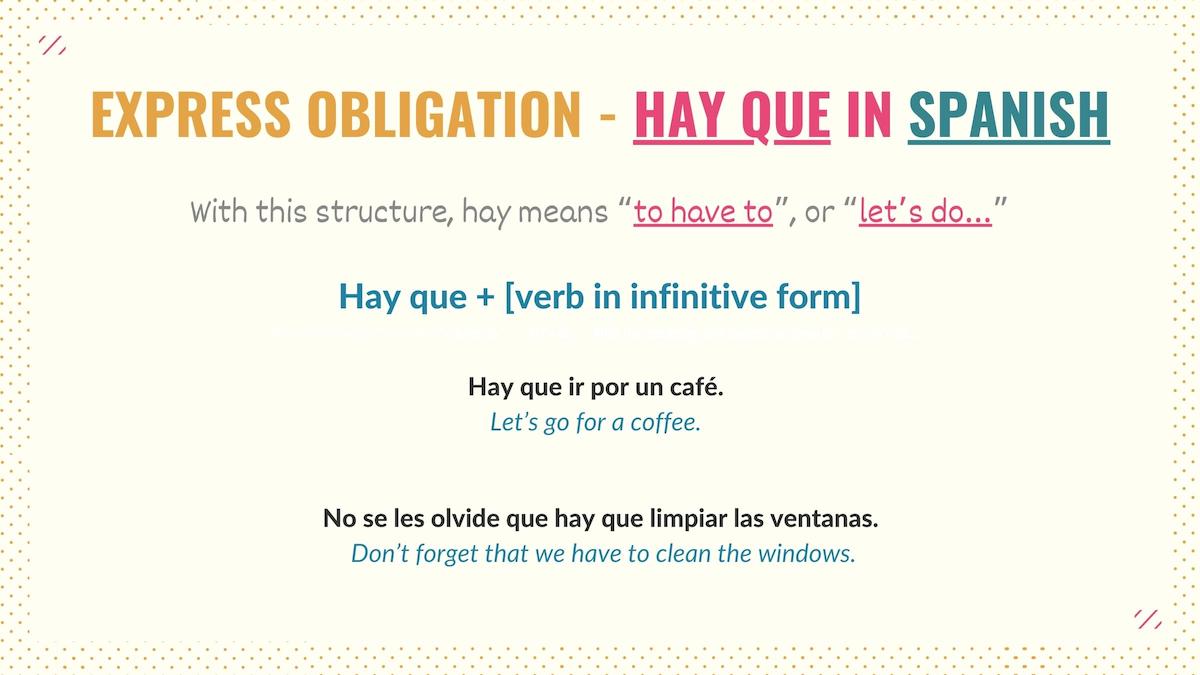
In Spanish, hay que + infinitive is a common structure used to express obligation or to present a proposal to someone. With this meaning, hay means “to have to”, or “let’s do…”.
Because it’s an impersonal form of haber, the obligation expressed with this structure is not addressing someone in particular. Therefore the subject is implied based on the context. Check the examples below:
Hay que + [verb in infinitive]
Hay que comprar más leche.
We have to buy more milk.
Hay que ir por un café.
Let’s go for a coffee.
No se les olvide que hay que limpiar las ventanas.
Don’t forget that we have to clean the windows.
Take Note: Because there are no subject pronouns or conjugated verbs that indicate who is performing the action, ‘hay que’ expresses impersonal obligation. To communicate obligation more concretely, you must use the verb tener with the phrase structure ‘tener (conjugated) que’.
Tenemos que limpiar las ventanas.
We have to clean the windows.
Sandra, tienes que limpiar las ventanas.
Sandra, you have to clean the windows.
Haber and tener are easily confused because they share the same translation (to have). But since there are significant distinctions between these words, you should learn how haber vs tener work.
Different Forms of ‘Hay’ in Spanish
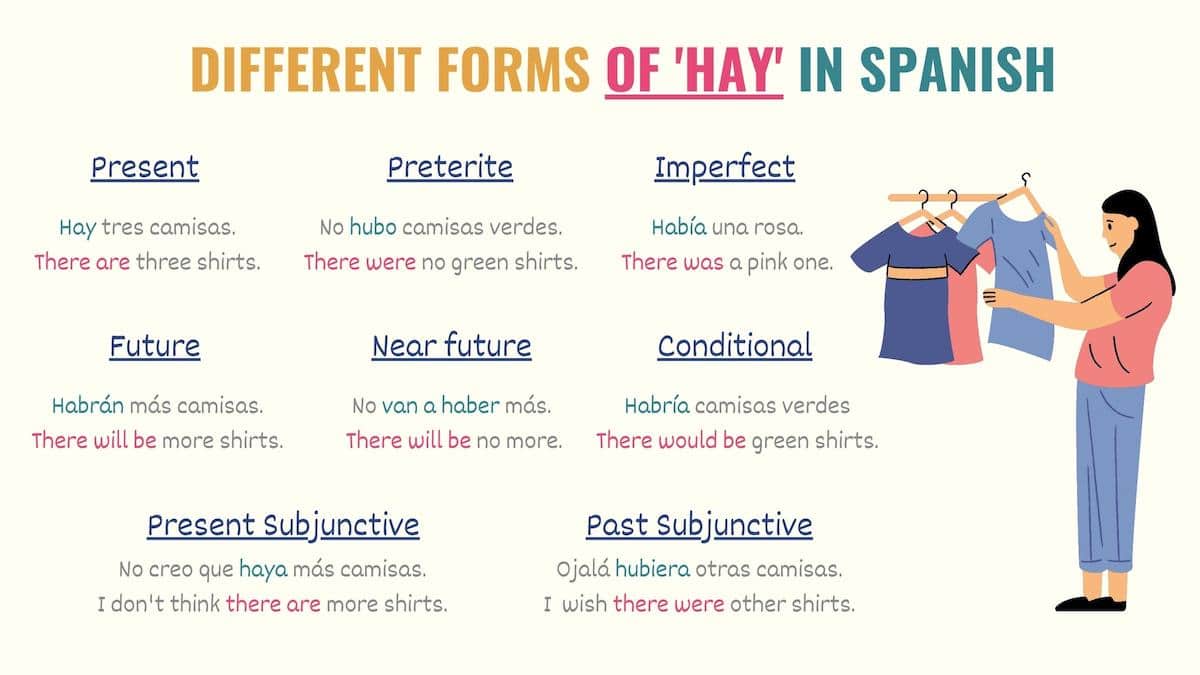
In Spanish, hay doesn’t have a plural form. To put it simply, it is always used in singular form regardless of the number of things you’re referring to. However, you can conjugate hay to other tenses to reflect the existence of something or obligations at different points in time.
Here are the different forms of hay in Spanish:
- Hay – Present tense
- Había – Imperfect tense
- Hubo – Preterite
- Habrá – Future tense
- Habría – Conditional tense
- Va a haber – Near future
- Haya – Present subjunctive
- Hubiera – Past subjunctive
And here are some examples of these forms:
Ayer había muchos niños en la calle.
Yesterday, there were a lot of kids in the street.
¿Cree que haya otro asiento junto a la ventana?
Do you think there is another window seat?
Va a haber otra función, por si quieres ir.
There’s going to be another showing if you want to go.
Common Phrases & Idioms with Hay
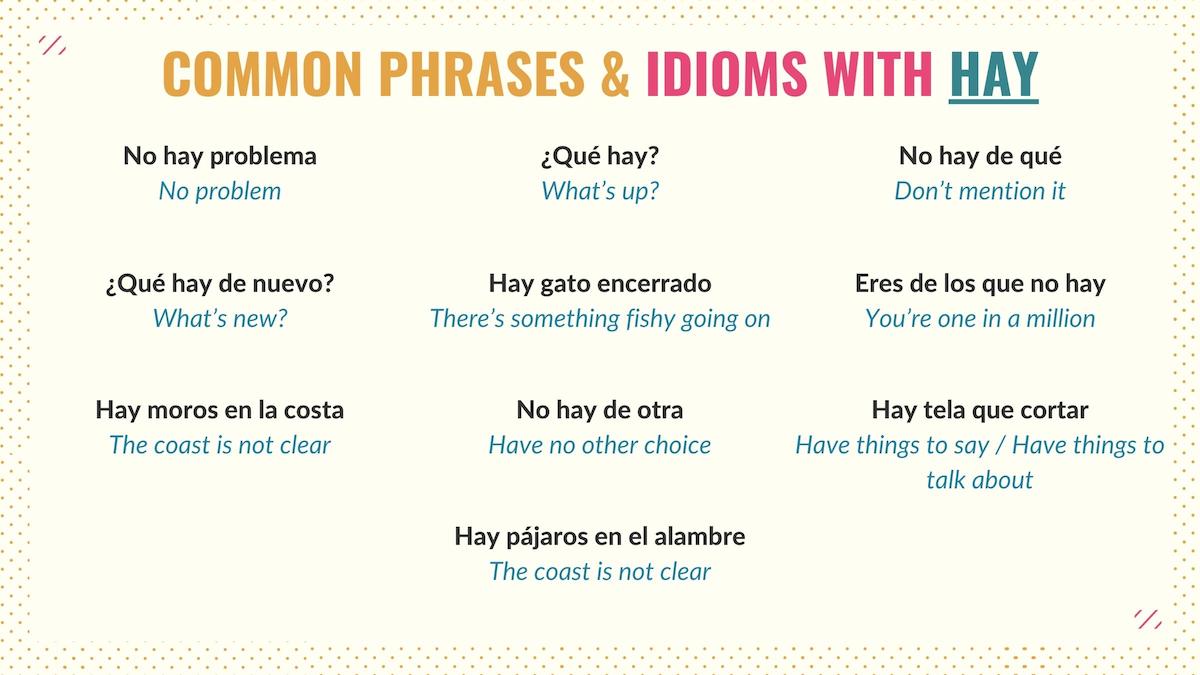
As you’ve learned, the standard uses of hay are to express obligation and to indicate the existence of something. However, ‘hay’ is also used to build some common idioms and expressions.
- No hay problema – No problem
- ¿Qué hay? – What’s up?
- No hay de qué – Don’t mention it
- ¿Qué hay de nuevo? – What’s new?
- Hay gato encerrado – There’s something fishy going on
- Eres de los que no hay – You’re one in a million
- Hay moros en la costa – The coast is not clear
- No hay de otra – Have no other choice
- Hay tela que cortar – Have things to say / Have things to talk about
- Hay pájaros en el alambre – The coast is not clear
Like idioms, adding these expressions to your vocabulary can help you sound more natural.
Key Points: Hay in Spanish
Hay is one of the most commonly used words in Spanish. So, here are some key points that you should always remember:
- Hay is the impersonal form of haber.
- Hay in Spanish means ‘there is’ or ‘there are’.
- This word can be used to express obligation or to point out the existence/presence of a thing or person within a place.
- Hay que + [infinitive] is the structure you must use to express obligation.
- Hay + [determiner] + noun is the structure used to talk about existence.
- Although it’s always used in singular form, hay can be conjugated to different tenses.
Now, you’re ready to use hay and its different forms correctly. ¡Buena suerte!
Download the Spanish Hay PDF Cheat Sheet
I’ve created a downloadable PDF of the cheat sheets for this guide on how and when to use hay in Spanish. Feel free to grab your copy and study it on your own time!

